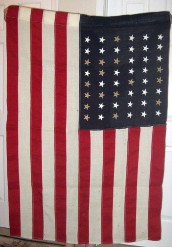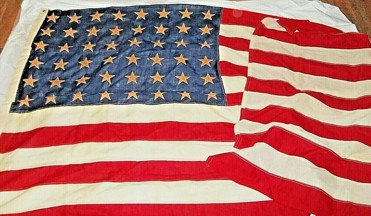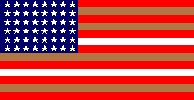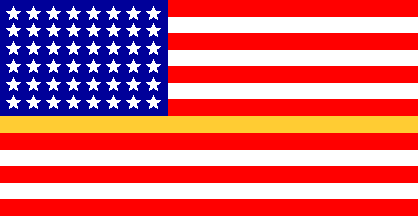 image provided by Susan, via Albert S. Kirsch, 12 July 2011
image provided by Susan, via Albert S. Kirsch, 12 July 2011

Last modified: 2024-11-23 by rick wyatt
Keywords: forty-eight | united states | gold stripes | gold stars |
Links: FOTW homepage |
search |
disclaimer and copyright |
write us |
mirrors
See also:
Editor's Note: This page contains information from discussions concerning flags with gold stripes or gold stars that originally were on the UFE pages
At some reasonably uncertain points during World War I, a number of flags were created that sometimes seem to be connected with military funerals. There are several design variants that have been observed:
 image provided by Susan, via Albert S. Kirsch, 12 July 2011
image provided by Susan, via Albert S. Kirsch, 12 July 2011
Based on comments received from inquirers to the FOTW website over the past ten years, and confirmation of their existence by Whitney Smith, flags with gold stars were definitely used for caskets of servicemen who died in action in Europe toward the end of World War II or shortly thereafter - it seems to have been a short lived phenomenon, and that only for bodies returned from southern Germany, as I recall (but that was the American zone). As for the reported use of gold stripes on casket flags, this seems to be a recent development.
Rob Raeside, 26 February 2010
My friends at Humphrys Flag Company in Philadelphia directed me to a comment they found on the "USA-flag-site.org" website about the use of gold stars and stripes: "A lady described to me a flag presented to her Mother in honor of her Father's death on the Bataan Death March. The flag has 5 gold stars randomly spread among the other 43 white stars. In researching the meaning of the gold stars for her, I came across a blog that stated that many American flags, used for military funerals during World War II, were made in France. These flags were hand stitched and many included varying numbers of gold stars mixed with the white stars. One man stated that he had a flag with 38 gold stars and 10 white stars. With the situation as it was in the United States and Europe at the time, quality control was not a big issue. One explanation of the gold stars was perhaps the French workers were aware of the Gold Star Mother's flag and added the gold stars as a similar honor. If anyone can verify, add to or deny this explanation, it would be appreciated."
John Udics, 2 March 2010
The Navy Department Library does not have any information on the subject of gold stripes on U.S. casket flags. However, the U.S. Army produced gold-star flags in the 48-star pattern as part of the ´Plan for Repatriation of the Dead of World War II´ (see the bibliography here: www.ibiblio.org), in which survivors of dead servicemen buried overseas could 'opt in' and have their relative's remains returned to the United States for re-interment in a National Cemetery. It is possible that the gold-striped flags could have been part of this program, or a related program.
James Allen Knechtmann, 9 March 2010
Reference Librarian, Navy Department Library, Naval History and Heritage Command
Comments from Dr. Langley, of the Smithsonian's Flag Department:
The matter of gold stars on casket flags came up during my time at the Smithsonian. In a telephone conversation with Whitney Smith I speculated that when the bodies of the dead servicemen were being returned starting, I believe, about 1948, the Army may have decided to contract out the making of casket flags rather than ship them from the US. Such would be in keeping with the goals of the Marshall Plan in Europe to stimulate recovery of war torn countries such as France. If so, local flag makers would have been familiar with the U.S. organization called Gold Star Mothers, established after World War I. They may also have been familiar with the practice of some American families who lost a son to display a service flag with a gold star in the window of a house. Many cities also displayed blue bunting banners with a star for every serviceman from that community. If that man or woman was killed or died in service, a gold star would be placed on the banner to honor the fallen service man or woman. (I presume that it was also done for the women in the various services, although I have no direct proof of the same.) The point is that whether the casket flags were made in France, Belgium, or Great Britain, or for the Pacific Theatre in the Philippines or Hawaii, there would have been direct knowledge of, and probable contact with members of the Gold Star Mothers. In Europe dating back to the post World War I era and in Hawaii and the Philippines after World War II.Dave Martucci, 2 April 2011
IT SEEMS PROBABLE that if local contractors made the casket flags for the dead of World War II, they MAY have sewn the gold stars with that idea in mind. I offered my opinion that this COULD have happened and Whitney misunderstood me and it became the definitive answer. The quotation that you sent exaggerates the idea even more. The only way that we may find out is if someone does a search of the Army and Navy records on the return of the war dead. Nobody thought to raise this issue when the people involved were still around.
In my Smithsonian days I knew about an exhibit of some casket flags sponsored by the American Legion and written up in the magazine of that organization. Some of the casket flags given to various families had been unrolled and people were curious that while many stars were the traditional ones, there were some that had a few gold stars. Later, from another source, I saw a photo of one that has 48 gold stars. There was speculation about the use of a few gold stars. One idea was that in the factory where these flags were made there may have been containers with both white and gold stars and that in the course of sewing the stars the sewer reached by mistake into the gold box instead of the white. Again this was all speculation. No one knows. It might be interesting to make an inventory of World War II casket flags from the European and Pacific theatres to see how often some or all gold stars were used and whether this practice extended to the Korean War. So there you have it. Much speculation and few facts.
I have been engaged in a series of email shots with James Allen Knechtmann, Reference Librarian, Navy Department
Library, Naval History and Heritage Command. He keeps referring me to the bibliography he cited, not to the publication "Plan for Repatriation of the Dead of World War II" and he does not seem to understand I found a digital copy of it online and could find no reference in it to flags of any kind. Jim Ferrigan also perused it and came up with the same conclusion, no mention of flags of any kind. I am still rattling Mr. Knechtmann about his source for the citation, but
I think this is rapidly going no where. I am more than ever being convinced the "gold stars in the 48 star flag" along with the "gold stripes on the flag" legends are just fabric failures, pure and simple. Otherwise there would be some documentary evidence of it from the period of use, either a short blurb in the newspapers or some obscure regulation in the military or something! So far, nothing has turned up. My mind is still open but not as much as it once was.
Dave Martucci, 8 April 2011
Recently I was just shown an American Flag with 48 gold stars and 48 white
stars on the other side. It has the customary red and white stripes. There are
no marking anywhere on the flag. The flag hooks are riveted into the inside
white stripe with the hooks to fly the flag. This flag was given to a fallen
soldier who died on the beaches of Normandy, on June 15, 1944. I have read some
of your material and with the information, possibly only one other flag with all
48 gold stars on one side has been seen.
David L. Mahan, 12 March
2018
 image located by William Garrison, 19 October 2024
image located by William Garrison, 19 October 2024
Source:
https://www.ebay.com/itm/373420200867
A post-WWII U.S. flag with all 48 "gold stars" instead of the usual white
stars, or a mixture thereof (54"x114"). From other comments posted here, this
flag was possibly made in France c. late 1940s.
William Garrison, 19
October 2024

|

|
I received this query about a casket flag. He seems to have ruled out fading as an explanation. Is there another? He said "I have a flag I received at my uncle's funeral in 1955. The 48-star flag that was placed on his casket... has several gold stripes where the white stripes should be. The first, second, fourth, and sixth white stripes are all gold, while the third and fifth are white."
Albert Kirsch, 24 October 2009
Since I'm no good at visualizing, I created this UFE by coloring in a 48-star flag. This only leaves two stripes white, which are not the outer stripes. If this colouring was about those two stripes, those would have been gold instead. Or if specifically about white stripes, then the other stripes would have been grey, rather than gold. So, it must be about the gold stripes. But if it would be about four gold stripes, then the best way to distribute them would be with the white stripes on the outside. In this case, the white stripes divide the gold into three bands with roughly the same amount of gold. If we interpret this as a military custom related to rank; do we have a rank that is symbolised by three gold bands?
Peter Hans van den Muijzenberg, 7 January 2010
"I have a large 48 star flag the size given at funerals when a serviceman dies. The first stripe below the stars is gold rather than white like the rest. What does this signify? Is this a veteran killed in the war? Thanks, Judy."
Yet another inquiry concerning gold stripes on the U.S. flag. Is there really anything to this?
Al Kirsch, 25 February 2010

Speculative Image by Peter Hans van den Muijzenberg, 26 February 2010
This would appear to be some sort of tradition. Both flags have 48 Stars (1912-1959) which suggests that the custom might not exist anymore. It also appears that the custom is casket flags related, and that a couple questions need to be asked:
Pete Loeser received this reply about gold stripes from the American Legion:
"As the fifteen-year resident flag 'guru' here at National Headquarters, this is the first time we have ever been asked this question! From time to time we will receive a question about 48-star flags with gold stars. Have you made contact with Dr. Whitney Smith? He is THE FLAG GURU and might be able to offer some insight. If you do come across something would you mind sharing it with us?"
Michael Buss, 26 February 2010
Assistant Director, Americanism and Children & Youth Division.
For a number of years, the U.S. Veterans' Administration, and before that the Defense, and earlier, War and Navy, Departments have more or less supervised the business of casket flags for service personnel and veterans. Today, and for as long as most of us recall, the VA in fact buys, specifies and supplies the 5 x 9.5 foot flags that are used for this purpose. So I should think that a query to the VA, perhaps directed at their archives or historic office, might answer the question of the gold stripes. Including a photo or gif would probably help, if such a thing is available. A 48-star flag would date back 50 years at least, but not more than 98 years; that would mean that the War Department may have been in charge. Those people keep fairly good historical records, so a query there might eventually yield some sort of a reliable reply. Much as I respect and salute the various non-governmental veteran´s organizations -- VFW, American Legion, DAR, etc. - they are not the real arbiters of this question, and I doubt that they have definitive resources to respond. I have a suspicion, as Al Kirsch probably does too, that there is a very interesting story lurking behind this incident someplace, if only we can find it.
Bill Dunning, 27 February 2010
Believe it or not, I got a thank-you note from the second enquirer (Judy) for my (our) efforts, and she said her flag was stamped "Annin." Not French, then! She got the flag at an auction and knows nothing of its provenance, and that her late father (a WWII vet) had a standard casket flag. She's asking around the VFW, but we've been down that road ourselves....
Al Kirsch, 28 February 2010
My last inquiry about an Annin manufactured flag (UFE10-8) resulted in failure because apparently they only keep records for the last five years, but I still feel there is a story behind these gold striped flags, so I plan to ask them if they know anything about gold striped 48-star flags or the traditions behind them.
Pete Loeser, 28 February 2010
Pete Loeser received this reply from The Veterans of Foreign Wars
"This is the first time I have come across any U.S. Flag with anything other than red and white stripes. For that reason, we have no protocols for such a flag and would not consider it a proper burial Flag.
Steve Van Buskirk, Director of Programs, 1 March 2010
My own preference would be to make getting an actual photo of such a flag the top priority. There may be some story behind these reported gold stripe flags, but I think we ought to consider the number of cases. There were approximately 15 million U.S. veterans of World War II, and probably at least 2/3 have died by now... and that's not counting vets of other wars who have also died. How many reports of gold-striped flags are there? Four, five? Is the total less than double figures? Unless we get better information, and evidence that they occur more often than one in one million, I'd say these are just freaks, flukes, or even plain mis-seeings. I once saw a Greek flag with some gray stripes and some white ones. I don't think there was any significance to it beside the fact that the stripes fabric may have come from different lots, and thus aged/weathered at different rates. How "gold" - as opposed to "yellowed" - are the examples reported to us. If there really is some significance to these U.S. flags variants why are they so incredibly rare? [I'm not questioning the Gold stars on pre-20th Century U.S. flags - the story behind them has already been reported.]
Ned Smith, 3 March 2010
Over the past few years I've had a number of flags brought to my attention that have similar characteristics, they appear to be standard 48-star U.S. flags except that there are stripes of yellow that appear on some part of the flag. These presumably were done intentionally, but most of the men involved have died and their relatives now hope to find out what the meaning is - too late. There probably was some kind of symbolism having to do with the individual or military circumstances that is now lost. I wish I could help you on this but military and government authorities I have contacted don't seem to know either. I have some images of actual flags and will eventually pull them together to form an article in The Flag Bulletin which should at least give a better idea of the intentions of the makers.
Whitney Smith, 8 March 2010
UFE Editors Note: The following organizations were contacted and responded, but were unable to help.: Veterans of Foreign Wars, Annin Flag Company, American Legion, and the Veteran's Administration.
Pete Loeser, 9 March 2010
From U.S. Army Quartermaster Museum:
" I believe each stripe represents a particular amount of World War II deceased personnel. I will check, but I think each gold stripe stands for 50000. It was idea that arose from the U.S. Army Quartermaster Depot in Philadelphia where the flags were made to denote with a special gold stripe a fallen hero. It didn't matter what rank and it may have helped keep track of how many flags were being made too. Let me do some more research and I will get back to you."
Luther Hanson, U.S. Army QM Museum, 10 March 2010
More from the QM Museum:
" I was not able to find anything official either heraldic or graves registration wise. I checked all the QM Depot flag photos we have and all the articles on flag manufacturing we have. I do remember an article on the Internet ten years ago that reported seeing at least one gold striped flag on a railroad siding, with many other flagged caskets being transported, and I remember being told the stripe designated the 50000th dead service member. We did locate in the QM Depot records several notes suggesting that it was an idea of either Col. George Christie, Jr., head of manufacturing Division QM Depot, or Mrs. Helen Martin, Chief of the QM Flag Section. During World War II and for 30 years after, Helen was known as the Betsy Ross of the flag Section. So I definitely think it was an internal idea as there are no official plans for these flags with gold stripes to be manufactured. They were a symbolic way to honor the war dead and a way to inventory the flags at the same time. I will keep looking for supporting documentation."
Luther Hanson, U.S. Army QM Museum, 11 March 2010
We are researching the significance of the 48-Star flags with gold stripes and will send a complete response soon.
Kimberley Bernard, 10 March 2010
Memorial Programs Service, VA National Cemetery Administration
Could the gold-stripe idea (and the gold stars in the 48-star canton) have been suggested by the Gold-Star Service Flag which was introduced in World War I?
Bill Dunning, 13 March 2010
New Enquiry forwarded by Rob Raeside: "A friend has a flag that has been in their family that has red and white stripes along with gold stripes and 48 stars. What is the name of this flag and what year did it come out? Here is a picture of the flag. - Pat, 6 July 2010."
Rob Raeside, 7 July 2010
As this case is similar to two other cases, a few questions come to mind. I hope Pat can help us here: